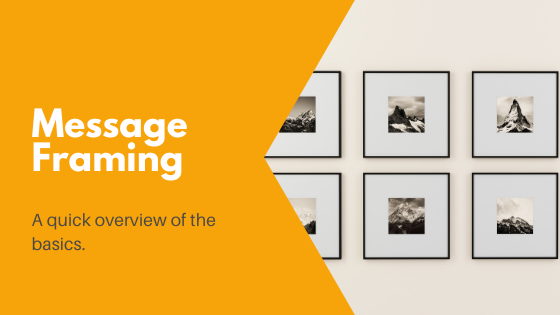Everything you need to know about message framing to write effective copy.

Message framing goes hand in hand with persuasion
As a marketer, you need to shape people’s view (e.g. their attitude towards your brand); move prospects to do something (e.g. buy your product); or even change their opinion on a specific topic (e.g. impressions of product quality).
In all of these situations, you have to frame your message for maximum impact.
What is message framing?
Framing a message refers to how you choose to present information to shape perception, stimulate a certain emotional response, or influence someone’s decision.
Most of the time, we either do so from a gain or loss perspective (there are other methods of framing as well, more on that below ↓).
The meaning or context doesn’t change but how a person feels about what’s being communicated probably will.
Message framing examples
For your reference, here are a few examples of framing you’ve probably come across before. Which frame resonates best with you?
| The glass is half full | The glass is half empty | ||
| 99% fat-free milk | Only 1% fat | ||
| There’s a 90% survival rate from this operation | There’s a 10% chance of dying from this operation | ||
| You’ve been gifted a 25% discount on your first purchase | Don’t miss out on a 25% discount off your first purchase | ||
| SALE: Get $300 off a $1500 designer bag | SALE: -20% on a $1500 designer bag |

Is framing important in marketing?
Fact: we’re all prone to a cognitive bias known as the framing effect. That is, our decisions are influenced by the way a question or fact is presented to us.
Take the operation example above.
Frankly, you’re more likely to go ahead with the procedure if you’re told there’s a 90% survival rate than if you’re told there’s a 10% chance you’re going to die. No wonder – one’s hopeful, the other’s fatalistic.
The same idea applies to marketing: the delivery of a message can be just as important as the message itself—it affects how convincing you are.
So yes, knowing how to use the framing effect to your advantage is a particularly desirable skill to have as a marketer, copywriter or PR professional!

Framing techniques in writing: What are the different ways to frame a message?
Below are some of the most common framing tactics you’ll find at play today. They’re used in all kinds of scenarios from stimulating sales to minimizing buying pain, preventing buyer’s remorse, or as part of social proof to name a few.
Positive / Gain Framing
This approach highlights the benefits, or what you will gain, by doing something. Positive or optimistic language is often used in gain framing.
For example: Invest in braces for a picture-perfect smile – in just 1 year!
Negative / Loss Framing
This approach highlights the risks, or what you would lose, by not doing something.
For example: If you don’t exercise every day, you increase your risk of heart disease.
Action-oriented Framing
To frame a statement in this manner, use active voice or incorporate a call to action.
For example: Stay safe, wear a mask. Order yours now!
Passive Framing
Unlike framing something in an action-oriented manner, passive framing involves having the subject be acted upon rather than actually do something.
Here’s a great example of action-oriented vs passive framing from Optimizely:
Active frame: Create a webpage for your business
Passive frame: Businesses grow faster online
Two-sided Framing
This refers to presenting both the pros and cons of something.
For example: Positive and negative reviews on e-commerce, hotel, or travel and tours websites
One-sided Framing
This is the opposite of two-sided framing, so only one kind of feedback – normally positive – is the focus of the information shared.
Reward Framing
This is an interesting one in that it’s all about how you communicate a reward so that the customer will perceive it as valuable.
For example: Get 140.000 miles INSTANTLY credited to your account when you sign up for our airline-branded credit card!
When you get this right, you’re not only able to get the customer to convert – you can even encourage repeat sales.
An example of that would be the good old-fashioned staple at every local coffee shop: Buy 10 cups of coffee and get the 11th for free. Coffee addicts the world over simply can’t resist!
Value Framing
Value frames are mostly used when you want to make someone feel like they’re getting a really good deal—better than the alternatives.
The example about surgery success rates from above is one example.
Here’s another you’ve seen time and time again: pricing a product at $9.99 instead of $10.
Now if you were advertising a discount for a $200 shirt, you’d probably advertise that they’d get $20 off rather than say it’s 10% off. Same discount, but saving $20 sounds like a sweeter deal than saving 10%.
By the way, we don’t just frame our messages in writing – we even do it when we speak and incorporate it in visual presentations.
Auditory Framing
Aside from wording, auditory framing has a lot to do with voice inflection: tone, pace, pitch, and intonation.
For example: If you were to ask me for directions to a restaurant and I respond, “Um, I think… so maaaaybe it’s that way? Like uh…take a left over there and then you should see it somewhere on your right”.
Chances are you’re going to ask someone else for directions, right? Just in case.
Now contrast that with a clear, confident tone: “Go straight then take a left at the next traffic light. Walk around 50 meters and it’ll be to your right.” This time, you’re assured of the information I gave you and will be on your way.
Visual Framing
Visual framing has to do with a variety of, as its name suggests, visual cues like color, font style and size, graphics and even body language.
For example: If I choose to use comic sans or wingdings as a font for this website, you’re probably not going to take anything I say all that seriously. It just gives off an unprofessional, childish vibe.
Another example: If you’re interviewing potential new hires, who gives off a better first impression: the person sitting slouched, constantly jiggling their leg or the interviewee sitting calmly with perfect posture?
One more example: Which of the following buttons are you more likely to click?
I’m guessing you’re leaning towards the blue one, right? That just feels like the better option. Here’s why: subconsciously, we’ve come to associate the color red with risk, negatives, stop or warning signs, which would naturally make you hesitate.
To conclude, all of these choices – big and small – are ways you choose to frame a message.
Takeaway: Knowing how to frame a message gives you the ability to nudge people in a certain direction and persuade them to take action.